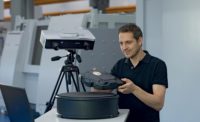It is common to hear "optical inspection and measurement," but is that one thing, or two separate processes? Optical inspection usually means visually observing a part to look for imperfections or inconsistencies with the desired outcome. Because it can be difficult to see these things at actual size, inspection is usually done by magnifying the part with a simple lens or a complex optical system. Dedicated illumination is typically used to enhance image quality. The magnified image can appear in an eyepiece, a projection screen or on a monitor if a camera is used to capture that image. Optical inspection is usually qualitative and somewhat subjective.
Optical measurement takes this process further by using the magnified image to measure attributes of the imaged part. The optics must be of good quality to faithfully present the image. Because it is the image that is measured, aberrations in the optics might be interpreted as deviations in part dimensions. A multiple magnification or zoom-lens system allows optical measuring systems to optimize the measurement of a range of feature sizes. Measurement systems include X-Y stages that allow different areas of a part to be brought into the optical field of view. Motion in the Z axis allows for focusing on surfaces of varying heights. Optical measurement is quantitative and objective. It lets manufacturers ensure that processes are under control and that parts are within specification. The optical measurement process can be manual, semi-automatic or fully automatic, depending on the system being used.
Manual measurement
In manual measurement, the operator typically locates a particular feature, optimizes the image quality and aligns an edge to a target. The target can be a reticle in the eyepiece, a centerline on a projection screen or a crosshair on a video monitor. In the case of part features that lie in a plane, distance is measured by translating the stage until the next part feature is at the target. A stage micrometer or encoder output to a display shows the distance the stage moved between the features that is a direct measure of the distance. Such measurements have resolution equal to that of the encoder.
Semi-automatic measurement
Semi-automatic measurement takes manual measurement a step further. By adding a computer, measurement sequences can prompt the user to do the measurements the same way every time. Image analysis in a video system can include automatic edge detection and focus optimization. Such tools direct every user to measure in the same way and rely on measurement software to remove operator-to-operator variability.
Automatic measurement
Auto-matic measurement takes the operator out of the process. Measurement systems with computer numerical control stages and zoom lenses, computers with powerful metrology software, automatic focus and edge detection, and multiple illumination sources, follow detailed computerized measurement routines, duplicating and optimizing conditions at each data point from part to part, operator-to-operator, shift to shift. Automatic measurement is the choreographed motion of X-Y-Z stages; magnification setting and calibration; selection and setting of illumination type, intensity and angle; and the acquisition and processing of data points; all ultimately leading to a digitized model that contains all the dimensional and angular relationships of the part under test. With automatic focus and Z-axis position readouts, full 3-D measurement is possible. Well-designed metrology software optimizes the results of measurement routines so users can concentrate on what they get out of video measurement instead of what they put into it.
Optical measurement is an accepted way of monitoring critical dimensions of manufactured parts in many industries today. It is noncontact, fast, accurate and reliable. Systems range from compact benchtop units to large-travel floor models. They measure single parts at a time, or pallets that are fitted with tens of parts. They are used in metrology labs, on shop floors and in work cells. Depending on the requirement, they are used from a few minutes per day to 24 hours a day, seven days a week, 365-days a year. Most manufactured parts, for consumer or industrial use, made of virtually any material, are probably measured on an optical system at some point in their production.
A good optical measurement system is more than the sum of the parts. The best systems come from companies that have been making the systems for years, learning from the past and applying the latest technologies to constantly improve accuracy, add functionality and increase value. Optical measurement can keep quality at the level that customers demand.



